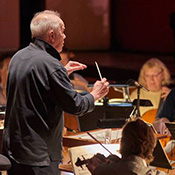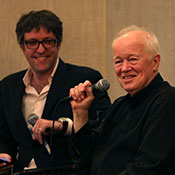
“The Ultimate Orchestra Builder”: Mark Niehaus on Edo de Waart
DAVID LEWELLEN
PUBLISHED
Tagged Under: 2016.17 Season, Conductor
As a player, Mark Niehaus appreciated Edo de Waart’s leadership and insistence on quality. As the orchestra’s executive director, he sees the same thing.
The Milwaukee Symphony’s Board of Directors took the unusual step of promoting Niehaus, formerly principal trumpet, to executive director in 2012. That gives him a unique perspective on de Waart’s eight-year tenure as music director, which ends with a late Romantic flourish this month.
But, Niehaus said, “Our relationship actually didn’t change that much. Good choices are good choices.”
As a conductor, de Waart balances tight leadership in a piece’s problem spots with freedom to let the orchestra go in more relaxed passages. “Less accomplished conductors skew to one side or the other,” Niehaus said. “But Edo’s body language is instantly understandable.” It is to benefit the composer and the listener: “He’s connecting Beethoven directly to the listener. He’s a vessel, the orchestra is a vessel, and the hall is a vessel to connect.”
Throughout the MSO’s financial ups and downs, de Waart insisted on maintaining the quality of performances, even if size and scope had to be scaled back. In the depths of the orchestra’s financial crisis of 2013.14, de Waart and Niehaus committed to the three-year plan of presenting semi-staged performances of the three Mozart-da Ponte operas — great music that could be performed by a relatively small orchestra. “I’m proud of us for that,” Niehaus said. “One of the world’s great opera conductors, leading one of the greatest orchestras in this country, to put on a showcase for Milwaukee. It went to the core of who we were and what we did.”
From almost every guest conductor, Niehaus hears something like, “Everyone told me the Milwaukee Symphony was really good and I should raise my expectations, but when I got here, they were even better.” Comments such as those, he said, are “a testimony to Edo and the work he’s done. Edo is the ultimate orchestra builder.”
Part of building an orchestra is hiring good musicians — de Waart will have appointed nearly 40 percent of the MSO by the end of his tenure — but part of it also is inspiring veteran players to elevate their game. “He’s created a cohesiveness and a commitment. It’s like a Ferrari now,” Niehaus said. “Every conductor marvels at the responsiveness of this instrument. This orchestra loves to get it right.”
De Waart has agreed to serve as conductor laureate while the MSO continues its search for his successor, meaning that he will conduct two weeks of concerts next year and will continue to audition and appoint new musicians.
The departing music director’s stamp on the orchestra makes it a more attractive job for conductors who aspire to take his place, Niehaus said. But partly because of the advance planning involved, finding the right person has been a slow process: “Someone conducts a great concert and we say, ‘Hey, we’d love to have you back again — in two years.’”
Niehaus praised the work of the search committee, led by former MSO board chair Doug Hagerman, and stressed that the new director will be a consensus choice. The classical world is full of tales of good conductors and good orchestras who did not succeed together because they were forced upon each other — “but we are stewarding a good process. We are absolutely going to set our next music director up for success.”
De Waart’s musical legacy has also put the orchestra in a better position to move into a new concert hall. For both fund-raising and construction, there are “multiple paths to success” to begin playing in the renovated Warner Grand Theater in the fall of 2019, Niehaus said. “But if people were questioning the quality of the core product, we could not think aspirationally.”
The music director and the executive director are “both very serious people with a silly adolescent side,” Niehaus said. “We’re continually trying to make each other laugh. And we both have 14-year-old sons, so we’ll talk about having their heads in their phones or outgrowing shoes. The conversation weaves in and out of music, family, and humor. It’s not linear, but we end up with a great result.”



